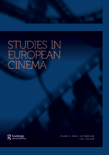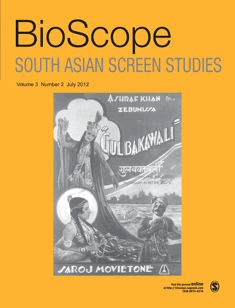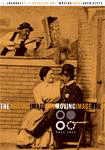
FILM CRITICISM
metrics 2024
Cultivating Critical Voices in Cinema
Introduction
FILM CRITICISM is a prestigious open-access journal dedicated to the study and review of cinema, offering a platform for scholars, critics, and students to engage deeply with the evolving landscape of film. Published by Film Criticism and based in the United States at Allegheny College, this journal has been contributing to film studies since 2002, with recent issues spanning from 2023 to 2024. Registered under ISSN 0163-5069, it is recognized in the Visual Arts and Performing Arts categories, achieving a commendable rank of #372 out of 667 in Scopus, placing it in the 44th percentile of its field. With an open-access policy implemented since 2016, FILM CRITICISM not only broadens accessibility to scholarly work but also enhances the dialogue around cinematic narratives, theories, and critiques. The journal's relevance is underscored by its current Q3 ranking, making it an essential resource for researchers and professionals alike who are invested in the critical examination of film.
Metrics 2024
 0.10
0.10 -
- 0.20
0.20 13
13Metrics History
Rank 2024
Scopus
JCI (Web Of Science)
Quartile History
Similar Journals

Studies in Russian and Soviet Cinema
Cultivating Insights into Cinematic Practices and CulturesStudies in Russian and Soviet Cinema, published by Routledge Journals, Taylor & Francis Ltd, provides a critical forum for the exploration and analysis of cinematic practices, histories, and cultures from the Russian and Soviet eras. With its ISSN 1750-3132 and E-ISSN 1750-3140, this journal operates under the editorial guidance of leading scholars in the field, making significant contributions to the Visual Arts and Performing Arts and Communication categories, where it is ranked in the upper quartiles of its peer group. The journal spans a rich period of study, converging insights from 2006 to 2024, thereby allowing for an in-depth understanding of the evolution and impact of cinema in societal narratives. Researchers and enthusiasts alike will appreciate its dedication to illuminating the often-neglected cinematic treasures of Russia and the Soviet Union, promoting scholarly discourse through its rigorous analyses and diverse range of articles. This journal serves as an essential resource for anyone interested in the intersections of film, culture, and history.

MILLENNIUM FILM JOURNAL
Engaging Minds Through Interdisciplinary Film Scholarship.MILLENNIUM FILM JOURNAL, published by MILLENNIUM FILM WORKSHOP INC, stands as a pivotal platform for exploration and discourse within the realm of film studies. With its ISSN 1064-5586, the journal has been noteworthy in delineating the complexities of visual arts and performing arts, contributing significantly to academic scholarship between the years 2009 to 2016, and in 2018. Though its coverage has been discontinued in Scopus, the journal has attained a respectable position within its category, ranking #320 out of 502 in the Arts and Humanities field. Researchers, professionals, and students alike are invited to engage with interdisciplinary discussions that illuminate the cultural and theoretical dimensions of cinema. While currently not offering open access options, the journal continues to serve as a vital resource for those deeply invested in the study of film, making it a respected voice in visual arts and performance research.

CINEASTE
Bridging Theory and Practice in Film StudiesCINEASTE is a distinguished journal dedicated to the critical exploration of cinema, providing a platform for scholars, filmmakers, and enthusiasts to engage with the complexities of film studies. Established and published by CINEASTE, this periodical serves as a vital resource for those interested in the intersection of visual arts and performing arts. Although it is not currently offered as Open Access, CINEASTE remains a respected publication within the academic community, having been indexed in Scopus until 2016. With an ISSN of 0009-7004, it has established itself despite its lower ranking in the arts and humanities category, reflecting the competitive nature of this field. Researchers, students, and professionals alike will find ample opportunities for insightful discussion and scholarly contributions to the evolving landscape of cinematic discourse. CINEASTE continues to uphold its mission of enhancing film scholarship, making it a crucial reference point for anyone eager to deepen their understanding of cinema's artistic and cultural significance.

Transnational Screens
Bridging Cultures Through the Lens of Contemporary MediaTransnational Screens is a premier academic journal published by Taylor & Francis Ltd, focusing on the dynamic intersections of visual arts, performing arts, and communication in a globalized context. Since its inception, the journal has garnered significant recognition, featuring in the Q1 category for Visual Arts and Performing Arts and Q3 for Communication as of 2023, reflecting its influential contributions to these fields. With a Scopus ranking placing it in the 78th percentile in Visual Arts and Performing Arts, this journal serves as a vital platform for researchers, professionals, and students aiming to explore the implications of transnational narratives in contemporary media and artistic practices. The journal is accessible to a diverse readership and promotes open dialogue through its commitment to publishing innovative and interdisciplinary research from 2020 to 2024. As a key resource for understanding the complexities of transnational screens, it invites submissions that push the boundaries of traditional scholarship and engage with pressing global issues through the lens of the visual and performing arts.

SIGHT AND SOUND
Pioneering Discussions in Visual Arts and PerformanceSIGHT AND SOUND is a prestigious journal published by the British Film Institute, dedicated to the exploration of cinema and its cultural significance. With an ISSN of 0037-4806 and an E-ISSN matching the same, this journal has been a critical platform for film studies since its inception, contributing valuable insights to the realms of visual arts and performing arts. Despite its discontinuation in the Scopus database post-2021, SIGHT AND SOUND commands respect within its field, currently holding a Q3 rank among Visual Arts and Performing Arts journals. Operating from 21 Stephen Street, London W1P 1PL, England, it serves as a vital resource for researchers, professionals, and students looking to deepen their understanding of film theory, critique, and history. While access to its articles is not open, the journal continues to influence the discourse in film studies, making it a significant asset in academic and professional circles.

Studies in European Cinema
Enriching the Dialogue on European Cinematic PracticesStudies in European Cinema is an esteemed journal published by Routledge Journals, Taylor & Francis Ltd, focusing on the multifaceted realms of European cinema and its contextual relevance. With an ISSN of 1741-1548 and an E-ISSN of 2040-0594, this journal provides a dynamic platform for researchers and practitioners in the fields of Communication, Visual Arts, and Performing Arts. As reflected by its recent Scopus rankings, it holds a respectable position in the Arts and Humanities with an 84th percentile rank, indicating its significance and impact in the scholarly community. While not entirely open access, Studies in European Cinema seeks to foster critical discourse and analysis from 2004 to 2024, covering a broad spectrum of topics related to film studies, cultural representations, and the evolving narratives within European cinematic practices. Engaging with diverse theoretical frameworks, the journal aims to contribute to the vibrant dialogue surrounding European cinema, making it an essential resource for academics, filmmakers, and students alike who are passionate about exploring cinematic expression in a European context.

Journal of Chinese Cinemas
Showcasing Innovative Research in Chinese Film StudiesThe Journal of Chinese Cinemas, published by Routledge Journals, Taylor & Francis Ltd, is a leading platform dedicated to advancing the field of film studies with a focus on cinema from China. With an ISSN of 1750-8061 and an E-ISSN of 1750-807X, this journal provides a comprehensive examination of the cultural, social, and political dynamics inherent in Chinese cinema. Ranked in the Q3 category for Communication and Q1 for Visual Arts and Performing Arts in 2023, it stands out in the academic landscape, particularly noted for its innovative research and diverse discourse. It holds a respectable position in Scopus rankings, coming in at #219 within Visual Arts and Performing Arts, indicating its growing impact among scholars and practitioners alike. With its commitment to publishing high-quality research from 2012 onwards, the journal serves as an essential resource for researchers, professionals, and students eager to deepen their understanding of the evolving landscape of Chinese cinema.

Studies in Eastern European Cinema
Unveiling the Artistry of Eastern European FilmStudies in Eastern European Cinema is a distinguished journal dedicated to exploring the rich and diverse landscape of cinematic art in Eastern Europe. Published by Routledge Journals, Taylor & Francis Ltd, this journal has carved a unique niche since its inception in 2010, providing insightful analysis and fostering dialogue among scholars, professionals, and students in the fields of Communication and Visual Arts and Performing Arts. With a current impact factor reflected in its respective quartile rankings, which position it in Q4 in Communication and Q2 in Visual Arts and Performing Arts, the journal serves as an essential platform for research and discourse on the cinematic contributions of Eastern Europe. Featuring contributions that analyze historical contexts, artistic trends, and cultural implications, it aims to broaden the understanding of Eastern European cinema's role within the global film landscape. While it offers a traditional subscription model, its ongoing commitment from 2010 to 2024 ensures it remains at the forefront of academic inquiries, appealing to a growing audience dedicated to the appreciation and scholarship of Eastern European cinematic arts.

Bioscope-South Asian Screen Studies
Advancing Critical Dialogues in Screen StudiesBioscope-South Asian Screen Studies is an influential journal dedicated to advancing the field of screen studies in the South Asian context, published by SAGE Publications India Pvt Ltd. With an ISSN of 0974-9276 and an E-ISSN of 0976-352X, this journal spans a convergence of scholarly research from 2010 to 2024, providing a significant platform for interdisciplinary dialogue. Holding a Q3 rating in Communication and a Q2 rating in Visual Arts and Performing Arts in the 2023 category quartiles, it ranks 212th in its field on Scopus, reflecting its vital contribution to academic discourse. Bioscope aims to explore and critically analyze the rich tapestry of South Asian cinema, media, and performance arts, offering researchers, professionals, and students a valuable resource for deepening their understanding of regional and global cinematic narratives. Readers will find insightful articles that probe the cultural, social, and political dimensions of screen studies, making this journal an essential reference for anyone engaged in the evolving landscape of South Asian visual culture.

Moving Image
Charting New Territories in Moving Image ResearchMoving Image is a distinguished academic journal published by University of Minnesota Press, dedicated to the exploration and critical analysis of visual culture. With an ISSN of 1532-3978 and an E-ISSN of 1542-4235, this journal plays a vital role in advancing scholarship in the fields of Conservation, Visual Arts, and Performing Arts, offering insights from its notable publication history from 2013 to 2019 and again from 2021 to 2022. While it currently does not offer open access options, the journal is recognized as a crucial platform for disseminating research, reflected in its rankings—#442/667 in Visual Arts and Performing Arts and #87/103 in Conservation according to Scopus. Despite its placement in the Q4 quartile for both fields, Moving Image remains a key resource for scholars, students, and practitioners interested in the intricate dynamics of moving images in contemporary culture. Its commitment to fostering dialogue and innovation in visual studies ensures its relevance and influence within the academic community.